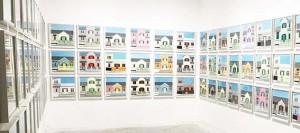Perumahan:
The dream of equality, the achievement of standardization, the regulation of normality and the perverse pleasure of difference.
Artjog 2018
Jogja National Museum
May 4 – June 4 2018
I have lived in a perumahan (housing estate) in Jogja for seven years. When it was built in 1986, all of the houses were the same, but today almost all of them are different. Perumahans were first built in Indonesia around the time of Independence. By standardizing construction, more homes could be built at a cheaper cost, but also the dream of equality could be realised; the perumahan signified a utopian “classless society” where all the houses and all the people who lived in them were equal (in theory). By the 1970s, the perumahan was no longer seen as a utopian ideal, but as the place where “normal” Indonesian families lived; or rather the stereotype of normality endorsed by institutions like Keluarga Berencana (The state family planning department) and the Soeharto regime. In the 1990s, people started to resent this rigid enforcement of normality. Consumers realized that they earned the admiration of their peers not by how they conformed to these limits, but by how they transgressed them. Today almost all the houses in my perumahan have been individualized; repainted, remodeled, second storeys added. In the 2000s, “Rumah Spanyol” conversions were popular, but more recently the “Rumah Minimalis” seems to be the trend. Living in my perumahan requires negotiating these contradictory layers of meaning.
Production assistants:
Eki Abdan and Kepet
Thanks to Krack Studio





